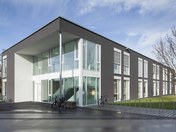History
Join us on a campus tour
|
Photo: Sandra Meyndt |
The Faculty of Engineering at the University of Freiburg was founded in 1995 as the 15th Faculty of Applied Sciences. We start our campus tour in building 101, the central teaching building on the airport campus. It was built in 1999 and opened in 2000. In addition to the large lecture halls and other teaching rooms, it houses the dean's office and the library of the Faculty of Engineering. |
|
Photo: Ute Blöd |
Art in building 101: "Jump and Twist", Dennis Oppenheim The artwork consists of three elements and represents a transition between outside and inside. The first element, which resembles a construction trailer, points diagonally towards the glass front, the second breaks through the façade, while the third floats in the interior and rotates transparently. The artwork is intended to combine technology and nature. Dennis Oppenheim is the American pioneer of land and body art and installation artist (1938-2011). |
 |
Buildings 051 and 025 were planned as barracks buildings in 1913. Building 051 was the crew building and building 025 was the officers' building. Both buildings were first used by the Germans and later by the French. The French left at the beginning of the 1990s and the site was acquired and used for new purposes: The Department of Computer Science (IIF) moved in in the mid-90s. (Note: Rifle racks can still be found in the corridors of the buildings today). |
 |
Across the street is the Solar Info Center, where there is rented space for the Department of Sustainable Systems Engineering (INATECH). The aim of INATECH is to establish sustainability as a guiding principle in the development of technical systems. |
|
Photo: Sandra Meyndt |
Buildings 102 and 103 are two laboratory buildings of the Department of Microsystems Engineering (IMTEK). IMTEK is one of the world's largest and leading academic research centers in the field of microsystems technology. Building 103 was completed in 2011, followed by building 104, a technology building with its own clean room, and finally building 102. Microsystems engineering was very attractive because it allows real products to be manufactured quickly. The production of semiconductors suggested a combination with computer science, which had previously been part of mathematics. The faculty was renamed the Faculty of Engineering in 2006/2007. Mission Statement (in German) of the Faculty of Engineering (11/2008). |
|
Photo: Ingeborg Lehmann |
The Integrated Robotics Center was opened in 2017. Scientists from the fields of medicine, philosophy, biology, computer science, microsystems engineering and law are working together to develop intelligent robots that perform tasks independently, learn from humans and their environment and act morally. |
|
Photo: Harald Neumann |
Building 105 is home to the FIT (Freiburg Center for Interactive Materials and Bioinspired Technologies). Scientists conduct research into the development of new material systems and technologies with life-like functions. The building is also home to the LivMats (Living, Adaptive and Energy-autonomous Materials Systems) Cluster of Excellence. The vision of the Cluster of Excellence is to combine the best of two worlds - nature and technology. |
 |
As the faculty developed very well from the outset, it was possible to construct another research building, building 106. |
|
Photo: Studierendenwerk |
The Studierendenwerk has built student residences for students on the Faculty of Engineering campus. Around 500 students live here in single rooms and shared flats. On the initiative of the Faculty of Engineering, childcare is also available here. Children of students and members of the university can be looked after in the KiTa Wolkengarten on the first floor of the Campus I building. |
 |
Since 2000, there has been a need for technology transfer and the opportunity to support spin-offs. This is why the FRIZ (Freiburg Innovation Center) was founded in building 302. Building 301 houses the Fraunhofer Institute for Physical Measurement Techniques (IPM). The Faculty of Engineering, in particular the Department of Sustainable Systems Engineering, maintains close cooperation with all five Fraunhofer Institutes. |
 |
IMBIT (Intelligent Machine-Brain Interfacing Technology) is concerned with research into the neurobiological mechanisms as well as the technical and medical foundations of long-term neuronal interfaces for bidirectional interaction between the brain and novel autonomous robotic systems through to practical applications. It emerged from the work in the BainLinks-Brain Tools Cluster of Excellence at the university. Researchers from various faculties work together here: Biology, Humanities, Medicine and the Faculty of Engineering, in particular colleagues from Microsystems Engineering and Computer Science. |
|
Photo: Michael Spiegelhalter |
Art in front of an IMTEK building: double role by Olaf Metzel Two rolls are rolled into each other and symbolize two spheres that interact with each other: study - research, teaching - learning, science - business, basics - application, biosphere - technosphere. Olaf Metzel is a German sculptor and object artist. |
|
Photo: Klaus Polkowski (Pressefoto) |
The growth continues: |









